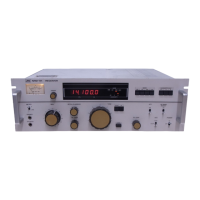No.
Control
Function
6
MODE selector Used for selecting the
reception *oà.
(one
of
SSB, CW, DSB
and AUX).
When
changing the mode from
one of
AUX,
DSB
and CW to
SSB,
the
frequency obtained
by
subtracting
1.5 kHz from
the
original
frequency
is displayed
on the
frequency indicatorO
. This
is
because that the
carrier
frequency
is displayed in case of SSB
reception.
Since AUX
is option,
make
a special order if
necessary.
If this AUX
mode
is specified when the optional crystal is not mounted,
actual reception mode is DSB even though
the AUX mode
is
indicated by the
MODE
indicator.
1 BANDWIDTH
selector
Selecting the bandwidth of
the
IF
filter
(intermediate
frequency)
(one
of
0.5 kHz,3
kHz
and
6
kHz).
8
METER selector
switch
Selecting
the
content
to be indicated
for
the meter(D.
When
setting this switch to
S,
turning
RF
GAIN
@
fully
clock-
wise, and
setting
the AGC
switch
@
to FAST or
SLOW,
the meter
pointer
indicates the
relative signal
strength of
the
HF input of the
receiver.
When
setting
this switch to
LINE, the meter indicates
the line output level
(6000
balanced).
9 SPEAKER
jack
Used
for
connecting
the
special speaker,
NVA-92
or the
speaker
of 600C1 impedance.
l0 PHONES
jack
Used for
connecting
headphone
of 600C2
the optional headphones,
ST-3 or the
impedance.
ll
MHz selector
Used for setting the MHz
digit of the receiving
frequency.
The full rotation
of this knob
covers 30 bands
(
I MHz
step).
t2
BFO
&
CLARIFIER
knob
Serving
as BFO
adjustment
knob in
case of
CW mode.
This
knob
can vary the frequency of
45 5
kHz
beat oscillator
(BFO)
by more
than
t2
kIIz.
Therefore,
the tone
of the
telegraph signal
can be adjusted.
This
knob
also serves
as a
fine
adjustment knob
(CLARI-
FIER) of
the
receiving tiequency
in SSB
and AUX modes.
This can vary the
center
frequency
of
the oscillating
fiequency by more
than
t50
Hz.
l3 RF GAIN
knob
is
Gain controller
for
the RF
amplifier and IF amplifier.
It
recommended
to adjust according to
the
strength
of
the
receiving
signal for
obtaining the optimum volume.
t4 TUNE
knob Used for
setting the receiving frequency in 100 Hz
steps.
The
full rotation
changes the
receiving frequency
by l0 kHz.
l5
UP/DOWN
switch
Fast forward
switch of the receiving frequency.
While
pressing
UP
(or
DOWN),
the
fiequency
increases
(or
decreases) at
a
speed
of approx. 125 kHz/second.
-
ll
-

